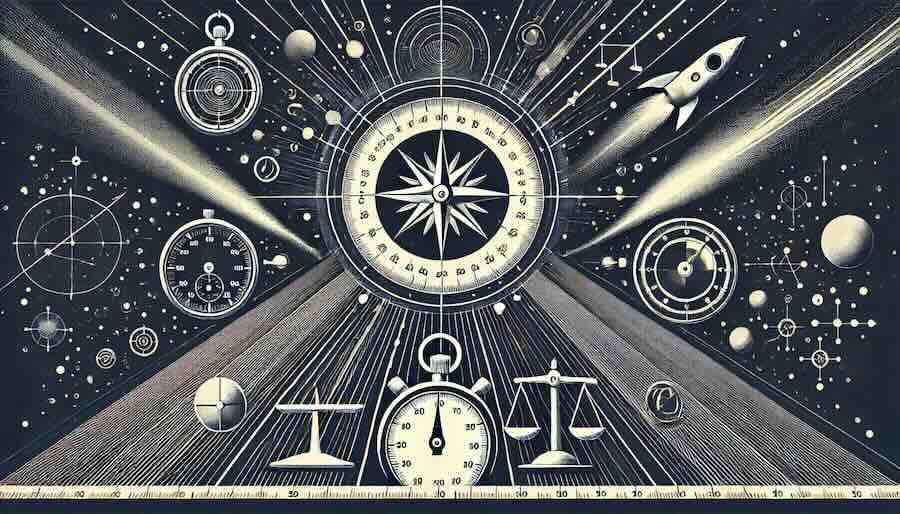Shoulders of Measurement Giants : quantum
January 23, 2025

Down to the Absurdly Small: From the Ultraviolet Catastrophe to String Theory
We love a good paradox in physics—those moments when the old theories wave their arms and say, “Wait, that doesn’t make sense!” One prime example is the “ultraviolet catastrophe.” It’s the puzzle that led us hurtling toward quantum theory, upending classical physics in the early 20th century and nudging us ever deeper into the realm of the absurdly small.
The Ultraviolet Catastrophe: A Brief Refresher
-
The Problem:
Classical physics predicted that a blackbody (an idealized object) should emit infinite energy at high (ultraviolet) frequencies. This made zero sense—nature doesn’t spontaneously spit out infinite energy just because something’s hot! -
Planck’s Bold Move:
Max Planck proposed energy quantization in 1900, suggesting energy is emitted in discrete chunks (quanta). This overcame the infinity fiasco and set the stage for quantum mechanics. -
Quantum Earthquake:
Planck’s idea soon spread, influencing Einstein’s photoelectric effect and Bohr’s atom model. Suddenly, matter and energy weren’t just continuous wave-like phenomena; they had “particle-like” lumps—a revelation that changed everything.
The Ever-Shrinking Scales: Why Size Matters
Atomic to Subatomic
- From Rutherford to Bohr: We went from discovering the nucleus (1909ish) to modeling electrons in orbits (or more accurately, orbitals). Each step probed smaller scales—What’s inside the nucleus?
- Probing Inside Protons and Neutrons: In the mid-20th century, experiments showed protons and neutrons weren’t fundamental either—they’re made of quarks.
Quantum Field Theory
- Fields, Not Just Particles: The 20th century also gave us quantum electrodynamics (QED), then the Standard Model, describing how fields produce quarks, leptons, and bosons.
- All Interactions, One Framework: The Standard Model accounts for electromagnetism, the strong nuclear force, and the weak nuclear force. It’s our best “map” of the subatomic landscape—though gravity still sits outside the party.
Strings? Is That The Next Frontier?
-
String Theory 101:
Instead of particles as point-like bits, string theory imagines tiny vibrating strings. The type of vibration determines whether you see a quark, an electron, or maybe a hypothetical graviton. -
Tiny? That’s an Understatement
These “strings” (if real) dwell around the Planck length (~10⁻³⁵ m)—so small it’s beyond even the dreamiest scope of direct measurement. Talk about “absurdly small”! -
Multiple Dimensions
String theories typically call for extra spatial dimensions—like 10 or 11 total. Why don’t we see them? They might be curled up or “compactified” at unfathomably small scales.
Table: Key Transitions from Big to Absurdly Small
| Epoch / Concept | Scale Explored | Big Leap of Understanding |
|---|---|---|
| Ultraviolet Catastrophe | Microscopic (light waves) | Necessitated quantum jumps |
| Atom Structure | Atomic (Ångström) | Discovery of nucleus, electron orbitals |
| Protons & Neutrons | Subatomic (femtometers) | Quarks revealed inside nucleons |
| Quantum Field Theory | Below 10⁻¹⁵ m | Fields produce particles; Standard Model evolves |
| String Theory | ~10⁻³⁵ m (Planck scale) | Hypothetical vibrating strings, extra dimensions |
Are We Near the Bottom?
Scientists debate whether strings (or some other exotic idea) represent the final rung of reality’s ladder. Perhaps we’ll keep finding “smaller” structures. Or maybe at some point, “size” itself stops being meaningful—quantum foam, anyone?
- Planck Length: The scale at which classical spacetime may melt into quantum chaos.
- Quantum Gravity: Our missing puzzle piece—gravity + quantum combined.
- Holographic Principles & Simulation Hypotheses: Some physicists argue the deeper we go, the more space, time, and “size” might be illusions of a more fundamental structure.
The Ongoing Quest
We started with the ultraviolet catastrophe—a fiasco that ironically birthed quantum mechanics. Now we’re rummaging for potential “strings” in hyper-dimensional space, aiming to unify all forces. Each discovery dethrones older notions and begs new questions. Are we any closer to an “ultimate scale,” or does the rabbit hole go on forever?
Takeaway: From Planck’s quanta to string theory’s vibrating loops, the journey to the absurdly small is fueled by paradoxes, leaps of imagination, and a dash of math wizardry. Maybe we’ll find a final theory—maybe not. But as history shows, each “end” is often just a new beginning.
| Related Blog Posts | Description |
|---|---|
| Shoulders of Measurement Giants: Big | How cosmic measurements contrast with quantum scales. |
| Shoulders of Measurement Giants: Cosmic | The largest distances in the universe—how does quantum mechanics fit in? |
| Shoulders of Measurement Giants: Small | From atoms to subatomic particles—where does classical measurement fail? |
